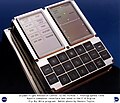Archivo:Apollo display and keyboard unit (DSKY) used on F-8 DFBW DVIDS683588.jpg
Apariencia

Tamaño de esta previsualización: 765 × 600 píxeles. Otras resoluciones: 306 × 240 píxeles · 612 × 480 píxeles · 980 × 768 píxeles · 1280 × 1004 píxeles · 2560 × 2007 píxeles · 3030 × 2376 píxeles.
Ver la imagen en su resolución original (3030 × 2376 píxeles; tamaño de archivo: 6,18 MB; tipo MIME: image/jpeg)
Historial del archivo
Haz clic sobre una fecha y hora para ver el archivo tal como apareció en ese momento.
| Fecha y hora | Miniatura | Dimensiones | Usuario | Comentario | |
|---|---|---|---|---|---|
| actual | 06:29 9 oct 2021 |  | 3030 × 2376 (6,18 MB) | Huntster | Cropped 9 % vertically using CropTool with lossless mode. |
| 06:28 9 oct 2021 |  | 3030 × 2606 (5,97 MB) | Huntster | Full resolution from NASA. | |
| 00:42 6 may 2015 |  | 1536 × 1321 (303 kB) | Fæ | == {{int:filedesc}} == {{milim | description = {{en|1=The display and keyboard (DSKY) unit used on the F-8 Digital Fly-By-Wire (DFBW) aircraft during Phase I of the fly-by-wire program. Warning lights are in the upper left section, displays in the uppe... |
Usos del archivo
La siguiente página usa este archivo:
Uso global del archivo
Las wikis siguientes utilizan este archivo:
- Uso en ar.wikipedia.org
- Uso en en.wikipedia.org
- Uso en fi.wikipedia.org
- Uso en fr.wikipedia.org
- Uso en he.wikipedia.org
- Uso en hu.wikipedia.org
- Uso en ja.wikipedia.org
- Uso en pl.wikipedia.org
- Uso en ru.wikipedia.org
- Uso en uk.wikipedia.org


